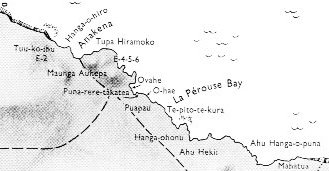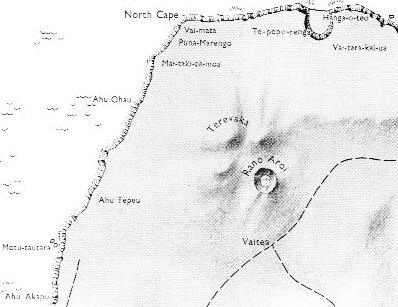However, according to Barthel 2 the 12th item in the 2nd list of names is not anywhere near Anakena, the 'beach' of the king, although it lies rather close to the center of the northeastern shore of the island:
"The 'deep watering place' (wordplay, 'fragrant watering place') is located a short distance south of Ahu Tepeu. Perhaps the additional name 'sun with weeping eyes' is connected with the 'weeping-eye' motif painted on dancing paddles ..." Instead, the 12th item evidently refers to a location on the western coast south of Ahu Tepeu - where Tuu Ko Ihu the carver of the wooden images (cfr at kava) lived:
Tuu Ko Ihu we should also remember for buring the skull of Hotu Matua in a very deep hole (at Ahu Tepeu). The technical term vai for this place is understandable - the 'skull' goes down deep and can definitely not be seen at the location of the 12th item. ... After Tuu Ko Ihu had reached up with his hands, he cut off the skull and put it into his basket. Out (went) the king, Tuu Ko Ihu, and ran to Ahu Tepeu. He had the skull with him. King Tuu Ko Ihu dug a hole, made it very deep, and let the skull slide into it. Then he cushioned the hole with grass and put barkcloth on top of it, covered it with a flat slab of stone (keho), and covered (everything) with soil. Finally, he put a very big stone on top of it, in the opening of the door, outside the house ... The flat slab of stone, keho, suggests a solstice, where the path of Sun (the ecliptic) does not appear to bend at all:
The word is similar to kehu (hidden), which in turn connects to ehu (ashes), as if kehu 'originally' meant 'covered by ashes'. Kekeho is coagulated blood, blood turned into a kind of dry (kehokeho) earth. To keep our model intact, with the northern coastline corresponding to the season when Sun is present on the island, we must count also the western coast as belonging to this Sun-is-present season. Looking again at the available maps we can see that the orientation of the map above is misleading. North is not straight up, which for instance this overview from Van Tilburg shows:
Here we can also see the 'political' areas with Ko Tu'u as a central mountain determining a shore line in the north which we can guess corresponds to our hypothetical Sun-is-present season. Spring with its vegetational growth will coincide with Sun 'eating' and coming closer (the stretch from a point somewhere north of Hangaroa up to the North Cape). Beyond high summer (the area around the North Cape) Sun will slowly withdraw in proportion to how the coastline recedes southwards. Our new and improved perspective of the island does not help much, though. Vai poko aa raa mata turu is not in the center of Sun's journey from the equator up to Easter Island and then back again. But its position could reflect the position of Rano Kau, if we place a mirror in between, maybe at Hangaroa. A solution to the problem at hand can be found if we assume there are 20 stations for Sun-is-present, because then the halfway station will be at item 24 - 10 = 14:
The 14th item in the 2nd list of place names is located 'close to Ahu Vai Matā' according to Barthel 2, and this is exactly where we hope it to be. The 'disoriented' map above has Vai-mata at the North Cape of the island. The ahu is not visible on the map, but the locations (according to Barthel 2) of item 13 and item 15 as 'not far from Ahu Maitaki Te Moa' respectively 'an ahu and a cave east of Ana Heu' makes the identification of item 14 exact and secure - item 14 represents the 'north cape of summer'. We must, of course, try to interpret the name hatu ngoio a taotao ika in order to see that there are meanings which agree with 'our map', and also to gain more knowledge which might be of value in reading the rongorongo texts. This endeavour needs a set of separate pages. |


